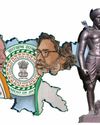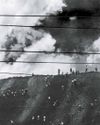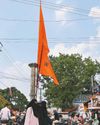Ahead of Burhan Wani’s death anniversary, fierce encounters and civilian deaths return to the Valley.

AT the martyrs’ graveyard in south Kashmir’s Tral town, two boys stood silently by the grave of Burhan Wani, the 22-year old who was killed by government forces in an encounter on July 8 last year in Kokernag. The boys, seventh-grade students at the local government school, raise their hands and pray for Burhan. Then they move aside and talk about the “healing power” of the soil of his grave. “People from far and wide come here and take handfuls of this soil,” says one of them. “They believe it can cure disease. My ailing mother asked me to get some soil from Burhan’s grave. She rubbed it on her face and instantly felt much better.”
Burhan’s engraved memorial plaque stands out, visible from quite a distance, in this graveyard where more than 50 militants slain by government forces are buried. Most are locals. People come here to pray for their “martyrs”. Some take away a handful of soil from Burhan’s grave. Clearly, everything about Burhan is sacred to them.
Sajad Ahmad, a 25-year-old driver standing nearby, overhears the boys’ conversation. “There are always visitors at Burhan’s grave and the crowds will swell in the days ahead,” Sajad says. All three, however, refuse to be photographed—quite unthinkable in these parts a year ago, when people poured into the streets on hearing “Burhan killed!” and scores of pictures of people mourning the slain Hizbul commander flooded the internet. So why this new found reticence?
Schoolboy Numan is quick with the reason: “The STF (Special Task Force, a counter-insurgency formation of the Jammu and Kashmir Police) will arrest us and beat us ruthlessly. We don’t mind being beaten by the STF if that could bring us azadi (freedom), but why get thrashed when azadi isn’t just around the corner?”
Denne historien er fra July 17, 2017-utgaven av Outlook.
Start din 7-dagers gratis prøveperiode på Magzter GOLD for å få tilgang til tusenvis av utvalgte premiumhistorier og 9000+ magasiner og aviser.
Allerede abonnent ? Logg på
Denne historien er fra July 17, 2017-utgaven av Outlook.
Start din 7-dagers gratis prøveperiode på Magzter GOLD for å få tilgang til tusenvis av utvalgte premiumhistorier og 9000+ magasiner og aviser.
Allerede abonnent? Logg på

Trump's White House 'Waapsi'
Donald Trump's victory in the US presidential election may very well mean an end to democracy in the near future

IMT Ghaziabad hosted its Annual Convocation Ceremony for the Class of 2024
Shri Suresh Narayanan, Chairman Managing Director of Nestlé India Limited, congratulated and motivated graduates at IMT Ghaziabad's Convocation 2024

Identity and 'Infiltrators'
The Jharkhand Assembly election has emerged as a high-stakes political contest, with the battle for power intensifying between key players in the state.

Beyond Deadlines
Bibek Debroy could engage with even those who were not aligned with his politics or economics

Portraying Absence
Exhibits at a group art show in Kolkata examine existence in the absence

Of Rivers, Jungles and Mountains
In Adivasi poetry, everything breathes, everything is alive and nothing is inferior to humans

Hemant Versus Himanta
Himanta Biswa Sarma brings his hate bandwagon to Jharkhand to rattle Hemant Soren’s tribal identity politics

A Smouldering Wasteland
As Jharkhand goes to the polls, people living in and around Jharia coalfield have just one request for the administration—a life free from smoke, fear and danger for their children

Search for a Narrative
By demanding a separate Sarna Code for the tribals, Hemant Soren has offered the larger issue of tribal identity before the voters

The Historic Bonhomie
While the BJP Is trying to invoke the trope of Bangladeshi infiltrators”, the ground reality paints a different picture pertaining to the historical significance of Muslim-Adivasi camaraderie